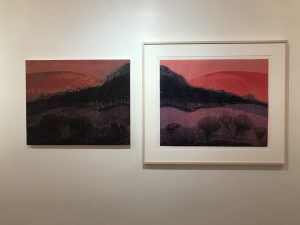I observed Soghra Khurasani as she grazed the space of Gitler & ____, an art gallery in Upper Manhattan dedicated to showcasing rising artists from around the world. It was a humid summer evening, the soupy air wafting its way into the open gallery. Visitors floated like foam on top of water, approaching Soghra one after the other to speak to her about her exhibit, entitled “SKIN.” She gracefully took questions, smiling brightly and modestly as she gestured to the piece the visitor spoke of. My water bottle perspired as the orange, August sun began to decline and the white walls of Gitler &____ glowed with Soghra’s artwork.
I asked Soghra, “What’s the silliest question you’ve been asked tonight?” She laughed politely and thought for a moment. She gestured to the piece closest to us, a print of a gorgeous, sunset, a purple mountain, mirroring its adjacent wood cut. Soghra reached out and touched the etches in the wood, birthed from scraping and hard-hitting. She said, laughing and smiling, “someone asked me if this was canvas.”
Soghra Khurasani is an artist from Vadodara, India. Soghra is primarily a print maker, using techniques such as woodcuts and etching prints. Printmaking, in layman terms, is the art of transferring images. Printmakers design and create prints using special techniques and tools to relocate an image from one form to another. This means lifting the image from a physical mould and moving it to a variety of surfaces. Soghra is extensively trained in creating large woodcut prints. She uses traditional techniques, such as the layering of colors, lines, and textures to create her unique artwork.
In Soghra’s newest collection, SKIN, she does much more than simply transfer images, she transfers herself as well. The body of work consists of fictional, dreamy landscapes which are meant to resemble human skin, flesh, tissue, and scars. Soghra puts her entire self into her work, in a very physical way. She bridges humanity and nature, in an effort to show that we are all connected to each other and to nature. Soghra refers to skin as something that separates people. We are defined by our skin, its color, and what it says about us. We are classified without our consent; we are divided. But Soghra’s art pushes us to think deeper about these constructs, begging us to look under the skin and recognize how similar we truly are. We are mountains, dreamy skylines, blood, tissue, and cells. She uses these aspects of nature to merge the etches in the wood, thus bridging the differences among human kind. We are connected by our scars, cuts, and flaws, and not by external appearance. We are more than our skin.
As explained in this video, Soghra uses her art as a metaphor for the present situations in her country, India. There is a great amount of sensitivity around “national identities, freedom of thought, secularism, violence, and gender-bias.” She expresses her anguish quite physically through her work. When Soghra works with wood cuts, she finds great relief in scratching and hard-hitting the board. The process is deeply cathartic and authentically hers — an angry release resulting in long, deep scratches across the wood, or small, impulsive etches, as natural as tapping on the table with an anxious heart.
The collection bares the question: What are we behind our skin? Under our masks, our class, our gender?
Under the skin, there is no religion or race. We are natural, living beings, deeply connected to each other and to nature.
Bright pinks, purples, and greens take flight over each wood and print. While Soghra usually only displays the finished print, in this particular exhibit, each print is hung next to or across from its mould. The mirror images create a series of origin stories for the onlooker. The white walls of Gitler & ___ were lit with both woodblock and print: woodblock marked and etched with various sharp tools, and painted over with layers and layers of paint. The print becomes a flat impression of Soghra’s outpouring of emotion, the scars and etches visible in the paint, a perfect copy. The original and the artificial hung closely in a playful, organic manner for the onlooker to interpret.
One gallery visitor expressed his confusion with the artwork. He initially told me he didn’t know exactly what he was looking at it, even though he was compelled by it. Once he recognized that the print was a mirror image of the woodblock, he began to understand it. The physical cuts in the wood make the art truly experiential. Seeing the woodblocks juxtaposed to the final prints help the onlooker understand the process of creation and how much actually goes into creating art like this.
There is something deeply compelling about the fictional aspects of Soghra’s collection, SKIN. Each piece seems to reflect a moment at either the beginning or the end of the day. Mountains composed of human skin and scar tissue, rivers formed of cell and membrane. These places are not real — they are images of places that could exist. Some pieces depict morning colors, some evening, or golden hour. For Soghra, it seems that fiction and reality collide under the human skin, the place where we all the look the same, and there are no borders.

Originally from small town Ontario, Emily Zimmer is a passionate creator with a love for writing music, poetry, and stories. She enjoys philosophy, coffee, and finding beauty in urban settings. Emily currently resides in New York City.






